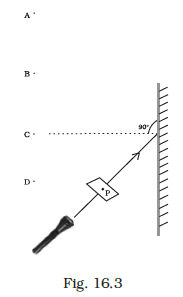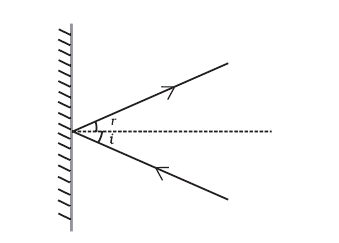Table of Contents
The NCERT Exemplar Solutions for Class 8 Science Chapter 16 provides a detailed answer to all of the chapter’s questions. When used in conjunction with textbooks, students will be able to increase their exam preparation. It will also eliminate the need for other books to be consulted.
You may also get NCERT Exemplar Solutions for Class 8 Maths and NCERT Exemplar Solutions for Class 8 Maths to help you revise the entire syllabus and improve your test scores.
NCERT Exemplar Solutions Class 8 Science Solutions Chapter 16 Light
Access Answers to the NCERT Exemplar Class 8 Science Chapter 16 – Light
Multiple Choice Questions
- Part of the eye which controls the light entering is called
(a) iris
(b) cornea
(c) lens
(d) retina
Answer – (a) iris
Explanation:
The iris, a dark muscular structure situated behind the cornea, functions to regulate the entry of light.
- We can see a non-luminous object when light:
(a) emitted by the object falls on the eye.
(b) is reflected from the object towards our eye.
(c) completely passes through the object.
(d) gets completely absorbed by the object.
Answer – (b) is reflected from the object towards our eye.
Explanation:
Non-luminous objects, which do not emit their own light, become visible to us when the light reflected by these objects enters our eyes.
- Light is falling on surface S1, S2, S3 as shown in Fig.16.1.

Surfaces on which the angle of incidence is equal to the angle of reflection is/are
(a) S1 only
(b) S1 and S2 only
(c) S2 and S3
(d) all the three surfaces
Answer – (d) all the three surfaces
Explanation:
The laws of reflection are consistently obeyed regardless of the object’s surface, ensuring that the angle of incidence equals the angle of reflection.
- A tiny mirror M is fixed on a piece of cardboard placed on a table. The cardboard is illuminated by light from a bulb. The position of the eye with respect to the position of the bulb is shown in Fig.16.2 as A, B, C and D. In which position mirror will be visible?

- A
- B
- C
- D
Answer – (a) A
Explanation:
When a ray of light from point A hits a mirror and reflects back, the angle of incidence equals the angle of reflection.
- A small hole P is made in a piece of cardboard. The hole is illuminated by a torch as shown in Fig. 16.3. The pencil of light coming out of the hole falls on a mirror.

At which point should the eye be placed so that the hole can be seen?
(a) A
(b) B
(c) C
(d) D
Answer – a) A
Explanation:
Positioning the eye at point A is essential as the hole becomes visible only when the angle of incidence matches the angle of reflection.
- Two mirrors A and B are placed at right angles to each other as shown in Fig.16.4.

A ray of light incident on mirror A at an angle of 250 falls on mirror B after reflection. The angle of reflection for the ray reflected from mirror B would be
(a) 250
(b) 500
(c) 650
(d) 1150
Answer – (c) 650
Explanation:
The angle of reflection for the ray reflected from mirror B will measure 65°, as the ray reflected from mirror A acts as the incident ray on mirror B and is then reflected back at a 65° angle.
- Which of the following statements is correct regarding rods and cones in the human eye?
(a) Cones are sensitive to dim light.
(b) Cones are sensitive to bright light.
(c) Rods are sensitive to bright light.
(d) Rods can sense colour.
Answer – (b) Cones are sensitive to bright light.
Explanation:
Cones are responsive to intense light, enabling them to perceive color, while rods are sensitive to low light levels and are unable to distinguish colors.
- In the figure of the human eye (Fig.16.5), the cornea is represented by the letter

(a) A
(b) B
(c) C
(d) D
Answer – (c) C
Explanation:
- Iris
- Lens
- Cornea
Very Short Answer Questions
- Name the part of the eye which gives colour to the eyes
Answer – The iris is the eye component responsible for its unique coloration. For instance, when someone is described as having blue eyes, it signifies the blue hue of their iris.
- Boojho while waving his hand very fast in front of his eyes, observes that his fingers appear blurred. What could be the reason for it?
Answer – The blurred vision experienced by Boojho when he swiftly moves his hand in front of his eyes is due to the phenomenon known as persistence of vision, causing his fingers to appear blurred.
- How many times is a ray of light reflected by two plane mirrors placed parallel and facing each other?
Answer – When two plane mirrors are positioned parallel to each other and facing each other, a ray of light can undergo multiple reflections indefinitely.
- The angle between the incident ray and the reflected ray is 60°. What is the value of the angle of incidence?
Answer – 30°.
Explanation:
The angle of reflection is equal to the angle of incidence. Since Angle of incident ray+ Angle of reflected ray is 60°.
The angle of incidence = 30°
- The distance between the object and its image formed by a plane mirror appears to be 24 cm. What is the distance between the mirror and the object?
Answer –
The distance will be 12 cm
Explanation:
Object +image formed =24 cm
Object +mirror =12 cm
Short Answer Questions
- What happens to light when it gets dispersed? Give an example.
Answer – When light undergoes dispersion, it separates into its constituent colors. An example of this is the formation of a rainbow, which occurs due to the dispersion of white light passing through water droplets.
- Draw Fig.16.6 showing the position of the plane mirror. Also, label the angle of incidence and angle of reflection on it.

Answer – 
In the figure depicting a plane mirror, the angles of incidence and reflection can be labeled to illustrate the reflection of light.
- Look at Fig.16.7. Can the image of the child in it be obtained on a screen?

Answer –
The image of the child in the figure cannot be obtained on a screen as it is a virtual image formed by a plane mirror, which cannot be captured on a screen.
- Eyes of the nocturnal birds have large cornea and a large pupil. How does this structure help them?
Answer – Nocturnal birds have large corneas and pupils to gather more ambient light, aiding them in seeing objects even in low light conditions.
- What kind of lens is there in our eyes? Where does it form the image of an object?
Answer – Our eyes contain convex lenses that focus light onto the retina, forming images of objects at the back of the eye
- Which part of the eye gets affected if someone is suffering from cataract? How is it treated?
Answer – Cataracts affect the eye lens, causing cloudiness. Treatment involves replacing the opaque lens with an artificial one.
Long Answer Questions
- Boojho planned activity to observe an object A through pipes as shown in Fig. 16.8, so that he could see objects which he could not directly see.

(a) How many mirrors should he use to see the objects?
(b) Indicate the positions of the mirrors in the figure.
(c) What must be the angle with respect to the incident light at which he should place the mirrors?
(d) Indicate the direction of the rays in the figure.
(e) If any of the mirrors are removed, will he be able to see the objects?
Answer –
(a) To observe objects through pipes, Boojho should use three plane mirrors.
(b) The mirrors should be positioned as shown in the figure.

(c) Mirrors should be placed at a 45° angle to the incident light for proper reflection.
(d) The direction of rays is indicated in the figure.

(e) Removing any mirror would prevent seeing the objects as the reflected rays are essential for visibility.
- There is a mistake in each of the following ray diagrams given as Fig. 16.9 a, b, and c. Make the necessary correction (s).

Answer – Corrected ray diagrams for figures (a), (b), and (c) are provided in the answer.

- Explain the process which enables us to perceive motion in a cartoon film.
Answer – Motion perception in a cartoon film is achieved by projecting static pictures in sequence at a high rate, creating the illusion of movement.
- How is the phenomenon of reflection used in making a kaleidoscope? What are the applications of a kaleidoscope?
Answer – Kaleidoscopes utilize reflection to create colorful patterns through multiple reflections within the device. They find applications in decoration, toys, and inspiring designers and artists.
- Fig. 16.10 shows the word REST written in two ways in front of a mirror. Show how the word would appear in the mirror.

Answer – In a plane mirror image, the word “REST” would appear laterally inverted, with the left side appearing on the right and vice versa.

- Write down the names of parts of the eye in the blank spaces shown in Fig. 16.10.

Answer – The parts of the eye shown in the figure are the ciliary muscle, iris, lens, cornea, retina, and optic nerve.
Class 8 Science Chapter 16 Light FAQs
Is Infinity Learn providing Solutions for Class 8 Science Chapter 16?
Yes, the Infinity Learn website comes with accurate and detailed solutions for all questions provided in the NCERT Textbook. Infinity Learn brings you NCERT Exemplar Solutions for Class 8 Science, made by our subject matter experts for a smooth and easy understanding of concepts. These solutions come with detailed step-by-step explanations of problems given in the NCERT Textbook. The NCERT Exemplar Solutions of this chapter can be downloaded in the form of a PDF and it can be used as a quick revision tool.
What are the Benefits of Downloading Infinity Learn's Class 8 Science Chapter 15 Solution?
There are numerous advantages to obtaining Infinity Learn's NCERT Exemplar Solutions for class 8 science chapter 16 pdf. If you want to learn more about those advantages, see the list of advantages for downloading class 8th science chapter 16 solutions below: Students can sign up for live online classes. Students can memorize all of the answers in order to improve their final science exam scores. All of the responses are 100 percent accurate and dependable. The most brilliant and experienced subject matter experts in India write the answers. Students can access academic help 24 hours a day, seven days a week.
Why Opt for Infinity Learn?
In this chapter, Infinity Learn provides videos, notes, NCERT textbook solutions, other practice book solutions, and assignments that help you learn the concepts and to memorize the concepts for entrance exams and board exams. Most important, Infinity Learn to provide instant doubt support by subject experts.









